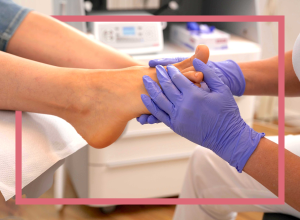The natural skin barrier in diabetics is often weakened, and this naturally also applies to the feet. Injuries and infections often heal more slowly in those affected. Special care must therefore be taken when caring for feet.
Diabetics should check and care for their feet daily due to an increased risk of problems. We have summarized here what proper foot care for diabetes mellitus can look like.
The right foot care for diabetes mellitus
If we are dealing with sensitive skin in people with diabetes mellitus, they can take very good precautions. These include, among others:
- regular checks of the feet.
- Wash your feet not too hot and with mild products. Then dry gently, including between the toes.
- Only gently remove calluses, for example with a pumice stone.
- Always file nails straight, never cut them, to reduce the risk of injury.
Ideally, a podiatrist should do this regularly or an expert should be consulted. They know how to treat the feet correctly. Above all, this is gentle, careful and cautious.
Why are these steps so important for diabetics?
Diabetes in particular can damage nerves and thus reduce sensitivity to pain. As a result, those affected simply notice injuries or burns far too late. Pressure points and calluses in shoes or injuries to the feet are not felt in time.
In the case of nerve damage caused by diabetes, this is aggravated by the fact that sweat glands are often impaired. However, if the feet do not sweat, overheating can occur and the skin dries out and becomes cracked. This also makes the skin susceptible to injuries or fungal infections – the reduced natural immune defense is to blame.
Fungal nail infections are often a precursor
“Fungal nail infections often pave the way for dangerous secondary bacterial infections, as fungi can penetrate the skin more easily than bacteria. Once the skin is damaged, bacteria also have an easy time of it. A fungal nail infection can trigger a whole wave of infections,” says podiatrist and expert Anke Niederau.
A nail fungus infection poses a particular risk for diabetics if they have what is known as diabetic foot syndrome. A distinction is made here between diabetic damage to the nerves (polyneuropathy) of the foot, which can lead to painless pressure sores, and damage to the blood vessels of the foot, which can lead to circulatory disorders and delayed wound healing and even the death of tissue parts (necrosis). In many cases, diabetic nerve damage, circulatory disorders and infections are present at the same time.
Foot problems are very common in diabetics
During treatment, it is so important to recognize typical diabetic emergency situations quickly and react appropriately.
So what can be done to strengthen the skin’s functions? In addition to the steps already mentioned, feet and lower legs can be creamed with moisturizing and moisture-binding care, such as Spirularin HF Mousse. Ingredients such as urea and glycerine support this. In the case of a fungal infection, special active ingredients in the care product can promote the natural defense against viruses and fungi.
However, a healthy and proper diet can also provide natural support for diabetes. This includes fresh fruit, vegetables and salads, pulses, wholegrain products, rice, pasta and low-fat dairy products. And last but not least, the right shoes and socks are the be-all and end-all. Breathable and natural materials and comfortable shoes are ideal for this.
If you have any questions, podiatrist Anke Niederau will be happy to answer them, simply send an email to: feetback@spirularin.de
If you would like to find out more about our foot care tips, sign up for our newsletter: Sign up here! In addition to valuable tips, there are always special promotions and advice topics, such as here in our expert tips.
Image source: Chinnapong/shutterstock.com






